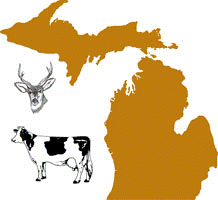Wildlife Disease and Zoonotics

Michigan Bovine Tuberculosis Bibliography and Database
Date of this Version
2004
Abstract
Mycobacterium bovis infection in wildlife and feral species is a potential source of infection for livestock and a threat to protected and endangered species. The aim of this study was to identify Spanish wild animal species infected with M. bovis through bacteriological culture and spacer oligonucleotide typing (spoligotyping) of isolates for epidemiological purposes. This study included samples from red deer (Cervus elaphus), fallow deer (Dama dama), wild boar (Sus scrofa), Iberian lynx (Lynx pardina), hare (Lepus europaeus), and cattle (Bos taurus). They were collected in several geographical areas that were selected for their unique ecological value and/or known relationships between wildlife and livestock. In the areas included in this survey, M. bovis strains with the same spoligotyping pattern were found infecting several wild species and livestock, which indicates an epidemiological link. A locally predominant spoligotype was found in these areas. Better understanding of the transmission and distribution of disease in these populations will permit more precise targeting of control measures.


Comments
Published in JOURNAL OF CLINICAL MICROBIOLOGY, June 2004, p. 2602–2608 Vol. 42, No. 6. DOI: 10.1128/JCM.42.6.2602–2608.2004 Copyright © 2004, American Society for Microbiology. Used by permission.